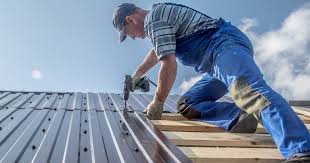How Often Should You Replace Your Roof?
Did you know that a damaged or aging roof can lead to costly repairs and even structural damage to your home? You’ve probably never given much thought to the condition of your roof. After all, it’s not something you see or think about every day, but its condition can impact how it can protect your home from the elements.
But how often do you need to replace your roof? From the type of roofing material to the climate in which you live, each material behaves uniquely, and harsh weather conditions, be it the sun, heavy rain, or snow, can impact your roof differently.
In this article, we’ll walk you through the average lifespan of different roofing materials, the signs that indicate your roof needs replacement, and expert recommendations for roof replacement frequency. By the end, you’ll have a better understanding of how to keep your roof in top shape and protect your home from the elements.
Average Lifespan of Different Roofing Materials
When considering the average lifespan of different roofing materials, take a closer look at the durability and longevity they offer.
- Asphalt Shingles: These shingles typically last between 20 and 30 years, making them a popular choice for homeowners looking for a cost-effective option. Take note that the lifespan of asphalt shingles can be affected by factors such as climate, maintenance, and installation quality.
- Metal Roofing: Metal roofs have a longer average lifespan, ranging from 40 to 70 years. They’re known for their durability and resistance to harsh weather conditions, such as strong winds and heavy rain. Requiring less maintenance compared to other roofing materials makes them a low-maintenance choice for homeowners.
- Wood shingles or shakes: For those looking for a more traditional and aesthetically pleasing option, this may be the way to go. Wood shingles typically last between 30 and 40 years, but they require regular maintenance to prevent rot and insect infestation. Although wood shingles aren’t recommended in areas prone to wildfires.
Factors That Affect the Lifespan of Your Roof
Understanding these factors and taking proactive measures can help you maximize the lifespan of your roofs. Regular inspections by roofing professionals and timely repairs or replacements when needed will contribute to the overall structural integrity and longevity of your roofing system.
- The quality of materials used. Investing in high-quality roofing materials can significantly enhance their durability and resistance to harsh weather conditions, and their proper installation by experienced professionals can ensure that your roof is sturdy and secure.
- Regular maintenance and inspection. By conducting regular inspections, you can identify and address any issues, such as leaks, damaged shingles, or clogged gutters, before they escalate into major problems. Cleaning your roof regularly to remove debris and prevent the growth of moss or algae can also help maintain its longevity.
- Climate. Extreme weather conditions, such as heavy rainfall, snow, hailstorms, or intense heat, can cause significant damage to your roof over time. Understanding the climate of your area can help you choose the appropriate roofing material that can withstand these conditions.
- Proper ventilation is needed in your attic. Poor ventilation can lead to moisture buildup, which can weaken the roof structure and cause damage. Ensuring adequate airflow can prevent such issues and prolong the lifespan of your roof.
Signs That Indicate Your Roof Needs Replacement
Recognizing signs that indicate your roof needs replacement helps maintain the integrity of your home and prevent potential damage.
- Leaky Roof: If you see water stains on your ceiling or walls, or if you notice water dripping into your home during rainstorms, it’s a clear indication that your roof is no longer providing the protection it should.
- Missing or Damaged Shingles: Over time, the shingles on your roof can become worn out or damaged by weather conditions. If you see any shingles that are cracked, curled, or completely missing, it’s a sign that your roof is in need of replacement.
- Granules in the Gutters: It’s a sign that your shingles are deteriorating and need to be replaced.
- Other signs include sagging or uneven roof surfaces, excessive mold or moss growth, and a roof that’s over 20 years old.
If you observe any of these signs, a consultation with a qualified roofing professional can help you assess the condition of your roof, provide recommendations, and guide you through the process of roof replacement if needed.
The Importance of Regular Roof Inspections
Regular roof inspections help maintain the longevity and functionality of your roof. By conducting regular inspections, you can identify and address any potential issues before they escalate into major problems. It’s recommended to have your roof inspected at least once a year, but it may be necessary to increase the frequency depending on the age of your roof and the weather conditions in your area.
During a roof inspection, a professional will carefully examine your roof for any signs of damage, such as missing or loose shingles, cracks, leaks, or wear and tear. They’ll also check the condition of the flashing, gutters, and downspouts to ensure proper drainage. If any issues are identified, they can be promptly addressed, preventing further damage and potentially saving you from costly repairs down the line.
Regular inspections not only help to extend the life of your roof but also protect your home and belongings from water damage. Leaks and moisture can lead to mold growth, structural damage, and compromised insulation. By detecting and fixing these issues early, you can prevent expensive repairs and maintain a safe and comfortable living environment.
Regular inspections can also be beneficial when it comes to insurance claims. If you ever need to file a claim for roof damage, having documented proof of regular inspections can strengthen your case and increase the likelihood of a successful claim.
Expert Recommendations for Roof Replacement Frequency
Roofing experts typically recommend considering roof replacement every 20 to 25 years. While this is a general guideline, the actual lifespan of your roof depends on various factors, such as the quality of materials, weather conditions, and regular maintenance. Keep in mind that waiting too long to replace your roof can lead to costly repairs and potential damage to your home.
Regular roof inspections can determine when it’s time to replace your roof. A professional roofer can assess the condition of your roof and provide expert recommendations based on their findings. They’ll look for signs of wear and tear, such as cracked or missing shingles, sagging areas, or water damage. They’ll also check for mold, rot, or any other structural issues that may compromise the integrity of your roof.
If your roof is approaching the 20 to 25 year mark or if you notice any signs of damage, it’s best to consult with a roofing professional. They can provide a thorough evaluation and advise you on the best course of action.
Conclusion
Regularly inspecting and maintaining your roof can ensure its longevity. The lifespan of your roof will depend on the type of material used and various factors, such as weather conditions and maintenance.
Signs indicating the need for replacement include leaks, cracked or missing shingles, and excessive wear and tear. Following expert recommendations and replacing your roof when needed will help protect your home and maintain its value.





